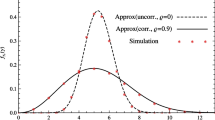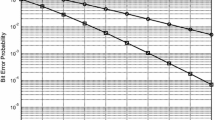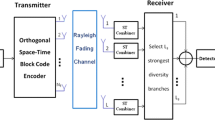Abstract
The effect of spatial correlation on channel capacity of orthogonal space–time block codes (OSTBCs) over multiple-input multiple-output Weibull fading under different adaptive transmission scheme is studied. In this paper, we have derive the moment generating function of the OSTBC received signal-to-noise ratio for integer Weibull parameter \(\beta \), considering spatial fading correlation. Utilizing the exact expression of the MGF, the probability density function has been simply achieved, thus enabling the exact evaluation of OSTBC capacity under distinct power and rate allocation schemes. Numerical outcomes illustrate the effect of fading severity \(\left( \beta \right) \) and fading correlation on the channel capacity and outline the performance differences among the distinctive adaptation schemes. It can be observed that OSTBC system with \(opra\) outperform the system with \(tifr\) adaptive scheme.




Similar content being viewed by others
Explore related subjects
Discover the latest articles, news and stories from top researchers in related subjects.References
Zheng, L., & Tse, D. N. C. (2003). Diversity and multiplexing: A fundamental tradeoff in multiple antenna channel. IEEE Transactions on Information Theory, 49(5), 1073–1096.
Alamouti, S. M. (1998). A simple transmit diversity technique for wireless communication. IEEE Journal Selected Areas in Communication, 16(8), 1451–1458.
Tarokh, V. H., Jafarkhani, H., & Calderbank, A. R. (1999). Space–time block codes from orthogonal designs. IEEE Transactions on Information Theory, 45(5), 1456–1467.
Sandhu, S., & Paulraj, A. (2000). Space time block codes: A capacitive perspective. IEEE Communications Letter, 4(12), 384–386.
Marzetta, T. L., & Hochwald, B. M. (1999). Capacity of a mobile multiple-antenna communication link in Rayleigh flat fading. IEEE Transactions on Information Theory, 45, 139–157.
Telatar, I. E. (1999). Capacity of multi-antenna Gaussian channels. European Transactions on Telecommunications, 10, 585–595.
Foschini, G. J., & Gans, M. J. (1998). On limits of wireless communication in a fading environment when using multiple antennas. Wireless Personal Communication, 6, 311–355.
Alouini, M. S., & Goldsmith, A. J. (1999). Capacity of Rayleigh fading channels under different adaptive transmission and diversity combining technique. IEEE Transaction on Vehicular Technology, 48(4), 1165–1181.
Mallik, R. K., Win, M. Z., Shao, J. W., Alouini, M. S., & Goldsmith, A. J. (2004). Capacity with adaptive transmission with maximum ratio combining in correlated Rayleigh fading. IEEE Transactions on Wireless Communications, 3(4), 1124–1133.
Maaref, A., & Aïssa, S. (2005). Capacity of space time block codes in MIMO Rayleigh fading with adaptive transmission and estimation errors. IEEE Transactions on Wireless Communications, 4(5), 2568–2578.
Pérez, J., Ibanez, J., Vielva, L., & Santamaria, I. (2005). Closed-form approximation for the outage capacity of orthogonal STBC. IEEE Wireless Communications Letters, 9(11), 961–963.
Pérez, J., Ibanez, J., Vielva, L., Perez-Blanco, D. J., & Santamaria, I. (2007). Tight closed-form approximation for the ergodic capacity of orthogonal STBC. IEEE Wireless Communications, 6(2), 452–457.
Palat, R. C., Annamalai, A., & Reed, J. (2008). An efficient method for evaluating information outage probability and ergodic capacity of OSTBC system. IEEE Wireless Communications Letters, 12(3), 191–193.
Xiao, H.-L., Ouyang, S., Nie, Z.-P., & Zhao, F. (2010). Capacity of orthogonalized Weibull MIMO channels under different adaptive transmission techniques. Wireless Personal Communications, 55(4), 539–550.
Bithas, P. S., & Mathiopoulos, P. T. (2009). Capacity of correlated generalized gamma fading with dual-branch selection diversity. IEEE Transactions on Vehicular Technology, 58(9), 5258–5663.
Xue, J., Caijun, Z., & Tharmalingam, R. (2012). Performance analysis of orthogonal STBC in generalized-fading MIMO channels. IEEE Transactions on Vehicular Technology, 61(3), 1473–1479.
Nechiporenko, T., Phan, K. T., Tellambura, C., & Nguyen, H. H. (2009). On the capacity of Rayleigh fading cooperative systems under adaptive transmission. IEEE Transactions on Wireless Communications, 8(4), 1626–1631.
Pan, G., Ekici, E., & Feng, Q. (2012). Capacity analysis of log-normal channels under various adaptive transmission schemes. IEEE Wireless Communications Letters, 16(3), 346–348.
Zhang, Y., & Tepedelenioglu, C. (2012). Asymptotic capacity analysis for adaptive transmission schemes under general fading distributions. IEEE Transactions on Information Theory, 58(2), 897–908.
Gozali, R., & Woerner, B. D. (2002). On the robustness of space–time block codes to spatial correlation. In Proc. IEEE Vehicular Technology Conf. (VTC-S’02), Birminghaml, pp. 832–836.
Femenias, G. (2004). BER performance of linear STBC from orthogonal designs over MIMO correlated Nakagami-\(m\) fading channels. IEEE Transactions on Vehicular Technology, 53(2), 307–317.
Babich, F., & Lombardi, G. (2000). Statistical analysis and characterization of the indoor propagation channel. IEEE Transactions on Communications, 48(3), 455–464.
Shepherd, N. H. (1977). Radio wave loss deviation and shadow loss at 900 MHz. IEEE Transactions on Vehicular Technology, VT–26, 309–313.
Bithas, P. S., Karagiannidis, G. K., Sagias, N. C., Mathiopoulos, P. T., Kotsopoulos, S. A., & Corazza, G. (2005). Performance analysis of a class of GSC receivers over nonidentical Weibull fading channels. IEEE Transactions on Vehicular Technology, 54(6), 1963–1970.
Karagiannidis, G. K., Zogas, D. A., & Kotsopoulos, S. A. (2003). An efficient approach to multivariate Nakagami-\(m\) distribution using Green’s matrix approximation. IEEE Transactions on Wireless Communications, 2(5), 883–889.
Karagiannidis, G. K., Zogas, D. A., & Kotsopoulos, S. A. (2003). On the multivariate Nakagami-\(m\) distribution with exponential correlation. IEEE Transactions on Communications, 51(8), 1240–1244.
[Online] Available: http://functions.wolfram.com/
Bellman, R. E., & Roth, R. S. (1984). The laplace transform. Singapore: World scientific.
Chauhan, S. S., & Kumar, S. (2014). Capacity analysis of adaptive transmission with space–time block codes in spatially correlated MIMO Nakagami-\(m\) fading channels. Wireless Personal Communications, 79(2), 1211–1222.
Gradshteyn, I. S., & Ryzhik, I. M. (2000). Table of integrals, series and products (6th ed.). San Diego: Academic.
Lombardo, P., Fedele, G., & Rao, M. M. (1999). MRC performance for binary signals in Nakagami fading with general branch correlation. IEEE Transactions on Communications, 47(1), 44–52.
Author information
Authors and Affiliations
Corresponding author
Appendices
Appendix 1
Substituting (15) into (16), the expression for the capacity \(\langle {C}\rangle _{ora}\) can be written as
where \(x=\frac{\beta Z}{2\overline{\gamma }_{c}\lambda _{m}}\) and \(x\frac{\left( {x\gamma }_{s} \right) ^{j-1}}{\varGamma \left( j \right) }\exp \left( -x\gamma _{s} \right) \) can be determined as
Thus substituting (36) into (35) and by using integration by parts (35) can be written as
Let \(1+\gamma _{s}=y\), then (37) can be rewritten as
By using binomial expansion [30], (1.111)] \(\left( t+a \right) ^{n}=\sum \nolimits _{k=0}^n \left( {\begin{array}{l} n\\ k\\ \end{array} } \right) t^{k}a^{n-k}\) and [30], (3.381.3)] \(\mathop {\int }\nolimits _n^\infty x^{v-1} \text {exp }(-ax)dx=a^{-v}\varGamma \left( v,an \right) \), we get
in which \(\varGamma \left( .,. \right) \) represent complementary incomplete gamma function and for q positive integer
where \(\mathcal {P}_{k}(.)\) is the Poisson sum and defined as [30]
For \(q=0, \varGamma \left( 0,c \right) =E_{1}\left( c \right) \), in which \(E_{1}\left( . \right) \) is the first order exponential integral function \(E_{1}\left( c \right) =\mathop {\int }\nolimits _1^{\infty } {\text {exp}(-ct)} / t dt\) [30]. Thus (39) can be written as
Thus, in the first term of (42) utilize (41) and in the second term of (42) interchanging the summation, we get
Appendix 2
Inserting (15) into (19), we get the equation that the maximal cut off SNR \(\gamma _{0}\) satisfy
Applying the identity \({\Gamma }\left( n,x \right) =\mathop {\int }\nolimits _x^\infty s^{n-1} e^{-s}ds\), (45) can be rewritten as
Let \(\gamma _{0}=x\) and describing
We have \(\frac{dG\left( x \right) }{dx}<0, \forall x>0\) and from (47), we achieve that \(\lim _{{x\rightarrow 0}^{+}}{G\left( x \right) }=+\infty \) and \(\lim _{{x\rightarrow +{\infty }}}{G\left( x \right) }=-1<0\). The solution of (48) required numerical root finding techniques. \(\varGamma (n,t)\approx \Gamma (n)\) for higher value of \(t\) and inserting it into (46), we get
Finally, after some manipulation \(\gamma _{0}\) is given in (24).
Rights and permissions
About this article
Cite this article
Chauhan, S.S., Kumar, S. Capacity of orthogonal space–time block codes in spatially correlated MIMO Weibull fading channel under various adaptive transmission techniques. Telecommun Syst 62, 101–110 (2016). https://doi.org/10.1007/s11235-015-0057-y
Published:
Issue Date:
DOI: https://doi.org/10.1007/s11235-015-0057-y




